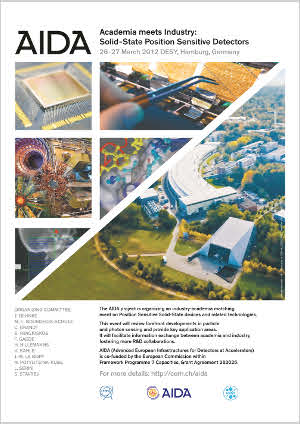
During its first annual meeting, the AIDA community also organised its first industry-academia workshop. Poster: AIDA
Proposed projects rely heavily on active R&D activities, young people willing to spend weeks in test beams, industry willing to tackle new technological challenges and infrastructures that will in the end help turn a few of the proposed projects into reality. The EU-programme AIDA (for Advanced European Infrastructures for Detectors at Accelerators) combines all these under one umbrella. At its first annual meeting, held at DESY in Hamburg, Germany, the institutions from more than 23 European countries involved in AIDA took stock of what was achieved during the first year and what still needs to be done.
AIDA’s annual meeting was a first in many ways. Obviously, after one year, it was the first big meeting after last year’s kick-off. There’s more, though. It was also the first time that researchers and industry met at an AIDA-organised workshop to learn about the needs and skills of the other, form new collaborations and develop new technologies together. This one concentrated on silicon detectors; the next one will also be tailored to the host institution by picking up its expertise. Also a first: students had the opportunity to attend a half-day tutorial about silicon detectors. These educational tutorials take the breadth of the AIDA programme beyond pure R&D.
AIDA covers all possible future projects in line with the European Strategy for Particle Physics: the LHC upgrade, linear colliders, neutrino facilities and Super-B factories. Many different sensor technologies are being used in the community, and although requirements can vary, there is a lot of overlap in the microelectronics sector. One goal was to get an overview over all the sensor technologies used, identify common topics and form subprojects where there is an overlap to avoid duplicate efforts and produce the best possible sensor for the community.
Another AIDA goal is developing the best possible beam telescope to serve two important test beam audiences – groups working on LHC upgrades and groups working on linear colliders. This telescope has to be versatile: while LHC upgrade tests primarily need the telescope to be speedy, the linear collider groups need it to be precise.
After this year’s premiere of the academia-industry workshop on silicon detectors, the next one will deal with microelectronics interconnections in conjunction with all the projects developed within AIDA. Future topics for the educational tutorials could include gas detectors, calorimetry or electronics and microelectronics. “We are certainly going to continue and expand this scheme,” says AIDA project coordinator Laurent Serin of IN2P3/CNRS in France. These tutorials are open to everybody, not only people from institutions involved in AIDA.
Among the various activities covered by AIDA, an area where Serin notices an increase in activity is the neutrino sector. Several institutes are working on prototypes for long-baseline neutrino experiment detectors and designing a dedicated low-energy test beam line at CERN. Linear collider and LHC-related tasks are proceeding and the community is expecting many results from test beams in 2012. Opening the project to new European partners was among the goals of AIDA, and indeed, a piece of R&D from Lithuania about dosimeters presented during the meeting could be changing the way the radiation measurement are done, Serin says. This new and more accurate dosimeter could replace the conventional ones if the first tests are confirmed.
Read more on individual projects – especially ILC-related CALICE and TPC news – in future issues of NewsLine.

Recent Comments